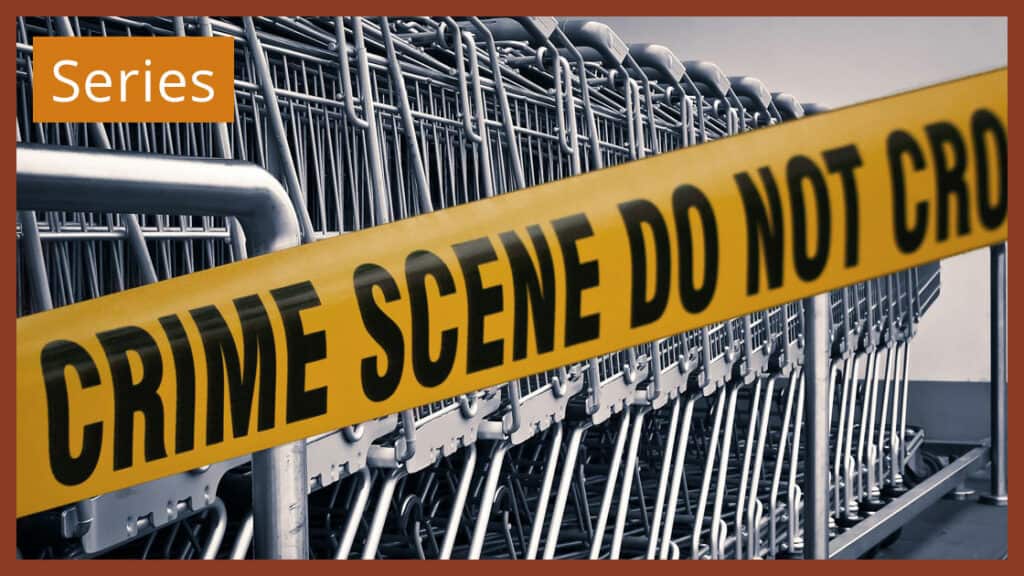This criminology blog series was inspired by questions that have come up recently, including: ‘Has COVID led to more food fraud?’ and ‘What is the impact of inflation on food fraud?’ While there is no statistically significant data yet, can you afford not to act to prevent food fraud?
‘Has COVID led to more food fraud?’ and ‘What is the impact of inflation on food fraud?’ are questions that are very difficult and complex to answer for two key reasons. First, ‘the dark figure of crime’[1] considers that only a fraction of crime is reported or detected. Second, there is often a long lag between when the novel types of crimes are conducted and when they are identified in reports. For example, COVID created unprecedented changes in the supply chain. Ukraine-Russia has forced alternate shipping routes and emergency actions for assurance of supply. There will be a lag between when related food fraud acts are conducted and when they are found after going through the supply chain. Then, there will be a lag between when the new types of food fraud are reported and someone identifies the new type of problem.
From a criminology theory perspective for identifying the root cause and prevention, there are many questions, such as what are we measuring? Who is measuring? Where are they reporting? Are they measuring and reporting meaningful information? Are we conducting measurements that detect the novel food fraud vulnerability?
Remember, there were data and detection challenges during the early stages of the melamine and horsemeat incidents. At the start of the incident, babies and pets were getting sick, but we didn’t know why. The first challenge was just trying to figure out the root cause. Next, there needed to be a focus on detection so products could be pulled from the shelves. Then the focus shifted to the root cause analysis to try to stop it from occurring. All these steps are introductory criminology concepts and a combination of situational crime prevention and crime scene investigation.
When focusing on food fraud prevention from a food safety perspective, addressing the problem is baffling. If the problem is a microbe, then we logically apply the field of microbiology. If the adversary is a human, it is logical to apply social science and criminology.
Criminologists are familiar with addressing novel problems.
Criminologists focus on what we know, which is the system weaknesses or vulnerabilities.
Criminologists then apply Situational Crime Prevention to identify, implement, assess, and then re-evaluate the problem. This is now a foundational concept in Food Fraud Prevention.
New Criminology Blog Post Series
This begins a new blog post series that will conduct a systematic review of criminology theories that form the foundation of efficient food fraud prevention. Remember, the goal is not to ‘catch’ food fraud but to prevent it from occurring in the first place. Also, to dissuade ALL food fraud acts, there must be a broad focus on ALL types of food fraud, including adulterant-substances, tampering, mislabeling, production overrun, theft, diversion/ gray market, and intellectual property rights counterfeiting.
When starting to research the root cause of food fraud, it was natural to focus on the human adversary. The study of humans is in the scholarly discipline of social science. The study of how humans relate is anthropology (not archaeology, which is Indiana Jones digging up ancient artifacts). The study of humans committing illegal acts is the scholarly discipline of criminology. Within criminology, there is a traditional focus on the adversary, and another focus on the environment – the environment is the ‘place’ where crime occurs.
Criminology Concepts for Food Fraud Prevention
This criminology blog post series will be based on what I consider the three essential food fraud criminology resources: Crime Analysis for Problem Solvers (2009, 2016, Clarke & Eck), Crime and Everyday Life (1994, 2018, Felson), and Situational Crime Prevention (1980, 2019, Clarke).
The critical concept starts with the SARA problem-solving model (scanning, assessment, response, and assessment). This method is used in order to understand the type of information available, how to dig into the root cause, and then the methods for identifying, implementing, and assessing a practical response.
Takeaway Points
- When dealing with a human adversary who is conducting a crime, it is most efficient to leverage Social Science and specifically Criminology. Fortunately, there is a history of crime prevention research that can be leveraged when we are conducting food fraud prevention.
- Let go of your need for statistically significant data before you review your food fraud vulnerability.
- Fortunately, there are many resources to help you to update your food fraud vulnerability assessment. You’ll probably find some easy steps if you start at a very high level and conduct a simple initial screening.
- As an example, it would logically be expected that there will be a reduced Ukrainian sunflower production. Ukraine is a major supplier of sunflower seeds and oils. Even without data, it is logical that the sunflower food fraud vulnerability changed. A simple first step could be to increase the monitoring of sunflower oil dilution, substitution, or even just short weights. You don’t need statistically significant data to realize you would be watching sunflower products.
References:
Clarke, Ronald and John Eck (2009) Crime Analysis for Problem Solvers – In 60 Small Steps, published by the Center for Problem-Oriented Policing under a grand from the US Department of Justice, https://cops.usdoj.gov/RIC/Publications/cops-w0047-pub.pdf
Felons, Markus Crime and Everyday Life (2018) Sixth Edition (though I recommend using the fourth edition), published by Sage Publishing, https://us.sagepub.com/en-us/nam/crime-and-everyday-life/book255558
Clarke, Ronald. (1980) Situational Crime Prevention: Theory and Practice. Harrow and Heston, Albany, https://www.scirp.org/(S(i43dyn45te-exjx455qlt3d2q))/reference/referencespapers.aspx?referenceid=1201585
Footnote:
[1] The term “dark figure of crime” was first used by the Belgian mathematician and sociologist Adolphe Quetelet in 1832. The dark figure of crime is crime that is neither reported nor recorded by law enforcement agencies. https://onlinelibrary.wiley.com/doi/abs/10.1002/9781118517383.wbeccj248#:~:text=The%20term%20%E2%80%9Cdark%20figure%20of,recorded%20by%20law%20enforcement%20agencies

